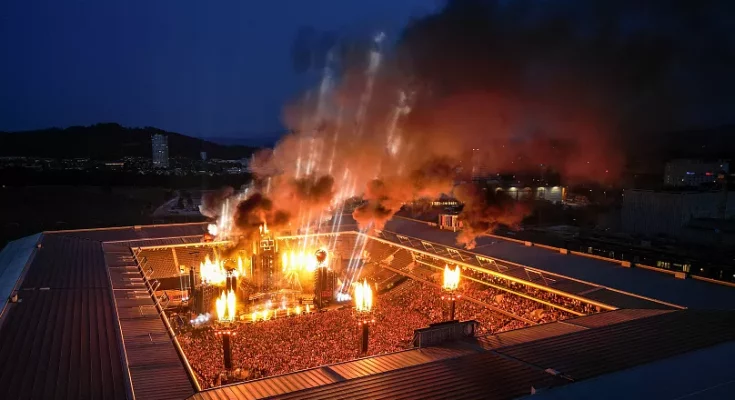Rammstein, the German industrial metal giant that has commanded global stages for decades, finds itself under a heavy cloud of scrutiny as authorities open investigations into allegations that its live shows may have crossed the line from provocative performance into environments where coercion and abuse could have taken place. The band, long known for its pyrotechnic spectacles, sexually charged imagery, and uncompromising stage presence, has been accused in various reports of creating atmospheres in which young women were allegedly targeted, pressured, and mistreated behind the façade of artistic entertainment. The question now haunting fans, critics, and investigators alike is whether Rammstein’s long-celebrated reputation as shock-rock pioneers has veiled darker dynamics of power, exploitation, and abuse.
For years, Rammstein has thrived on controversy. From their provocative lyrics to their flamboyant performances, they built a brand rooted in pushing societal limits and shocking audiences into both awe and discomfort. Their concerts became not only musical experiences but theatrical spectacles, laced with erotic symbolism, aggressive staging, and narratives that often danced dangerously close to taboos. Yet while much of this was historically defended as performance art, recent testimonies from concertgoers and backstage participants suggest that what happened beyond the stage lights may not have been entirely consensual. Reports have surfaced describing special recruitment systems where select women were invited to private after-parties, raising concerns that such environments blurred the line between fandom and manipulation.
The allegations are disturbing because they tap into a broader discourse about the music industry and the power dynamics embedded within it. Rammstein, with its loyal fanbase and commanding stage presence, wields immense influence over its audience. For many fans, attending a live show is not merely about music but about belonging to a community, sharing in the raw, unfiltered energy the band exudes. However, critics argue that this emotional vulnerability and devotion can be exploited, particularly when fans are drawn into private spheres where the band or its entourage hold disproportionate control. Investigators are now tasked with disentangling performance art from possible predatory practices, an effort complicated by the band’s long-standing reliance on shock tactics that often blur fantasy and reality.
Central to the controversy are accounts alleging that some women were approached by intermediaries—often dubbed “row zero” organizers—who offered them privileged access to areas closer to the stage or private gatherings afterward. These women report experiences that left them feeling pressured into situations they did not fully understand or consent to. Although Rammstein and its members have consistently denied wrongdoing, the sheer number of testimonies and the gravity of the allegations have prompted prosecutors in multiple jurisdictions to probe deeper. The investigation is not only about potential criminal acts but also about whether the structural setup of these shows enabled systemic abuse of power.
The cultural dimension cannot be ignored. Rammstein has long occupied a unique space in German and international music culture, challenging censorship, tackling taboo topics, and reveling in provocation. Their defenders argue that conflating stage theatrics with real-life abuse risks misrepresenting the essence of their art. They highlight that the band’s work has always courted controversy, often intentionally sparking discomfort to force audiences into confronting difficult truths about violence, sexuality, and authority. Yet detractors counter that such arguments risk providing cover for actual misconduct, framing predatory behavior as art while leaving victims silenced under the guise of performance. This tension between interpretation and accountability lies at the heart of the unfolding investigation.
For many fans, the news has been destabilizing. Rammstein concerts were once seen as cathartic celebrations of individuality, rebellion, and raw energy. Now, some attendees report reevaluating past experiences, questioning whether moments that seemed innocuous at the time may have had undertones of coercion. Fan communities online are fractured, with some fiercely defending the band against what they view as sensationalist allegations, while others express deep disappointment, acknowledging that their admiration may have blinded them to troubling dynamics. This polarization highlights the difficulty of separating cultural legacy from personal testimony, especially when the subjects of investigation wield near-mythic influence over their audience.
Legal systems face their own challenges in pursuing such cases. Establishing clear evidence of coercion or abuse in contexts where power imbalances and implied consent are murky is notoriously difficult. Much of the alleged misconduct is said to have occurred in private settings with limited witnesses, making corroboration challenging. Moreover, the band’s international touring schedule complicates matters, as incidents may span multiple jurisdictions with varying legal standards. Prosecutors must navigate not only evidentiary hurdles but also the cultural weight of investigating one of Germany’s most prominent musical exports. This complexity underscores the broader issue of accountability in entertainment, where celebrity status often provides both protection and influence.
The broader societal implications of the investigation extend beyond Rammstein. It has reignited conversations about the safety of women in music spaces, the role of power in fandom, and the responsibility of artists and their teams to ensure ethical conduct. Similar scandals have shaken the film industry, sports, and other cultural arenas, reflecting systemic issues rather than isolated incidents. Critics argue that the structures enabling such dynamics—unchecked power, lack of oversight, and blurred boundaries between professional and personal interactions—demand reform. For some, the Rammstein case is not merely about one band but about confronting an industry culture that has too often turned a blind eye to exploitation.
Yet amid these serious discussions, the presumption of innocence remains central. Rammstein has not been convicted of wrongdoing, and its members maintain that the allegations misrepresent their conduct and intentions. They have argued that their shows, while provocative, are meticulously staged pieces of performance art, and that any interactions with fans outside the performance context are consensual. Supporters caution against conflating allegations with facts, warning that public opinion can be swayed too easily by sensational reporting, potentially destroying reputations before due process is complete. This raises the delicate balance between amplifying victims’ voices and ensuring fairness in investigation.
The impact on the band’s career is undeniable. Concert organizers, sponsors, and venues are under pressure to reconsider their associations with Rammstein, fearing reputational damage. Some festivals and promoters have already tightened backstage access policies, while fan clubs face internal turmoil over whether to continue supporting the group. At the same time, Rammstein’s core fanbase, known for its loyalty, remains vocal in its support, arguing that the music transcends the controversy. Whether this support can withstand prolonged investigations and potential revelations remains uncertain. The future of the band’s touring and cultural influence hangs in the balance.
What makes this case particularly poignant is the symbolic role Rammstein plays in Germany’s cultural landscape. As a band that rose from post-reunification Berlin, they embodied a rebellious spirit, confronting taboos and giving voice to uncomfortable truths. Their music and performances have long been interpreted as social commentary, whether addressing fascism, sexuality, or violence. If the allegations prove substantiated, the irony would be bitter: a band celebrated for exposing power and oppression through art accused of perpetuating the very abuses it once critiqued. Such an outcome would tarnish not only their legacy but also the cultural narrative they helped shape.
For now, the investigation continues, weaving together testimonies, evidence, and cultural critique. The outcome is uncertain, but the process itself has already forced a reckoning—among fans, within the industry, and across society. It has prompted questions about what we are willing to accept in the name of art, how power operates within fandom, and where accountability lies when allegations challenge not only individuals but entire cultural institutions. Whether Rammstein emerges vindicated or condemned, the conversation sparked by these allegations will likely have a lasting impact on how live music is experienced and regulated in the future.
In the end, the controversy surrounding Rammstein’s live shows is not solely about one band or one set of allegations. It is about the intersection of power, art, and responsibility in cultural spaces. It is about recognizing the vulnerabilities of fans who step into environments where admiration and influence create dangerous imbalances. And it is about demanding accountability from those who benefit most from public trust and adoration. As investigators probe deeper, the world watches closely, knowing that the answers unearthed may reverberate far beyond the walls of concert halls and into the very heart of cultural ethics.



